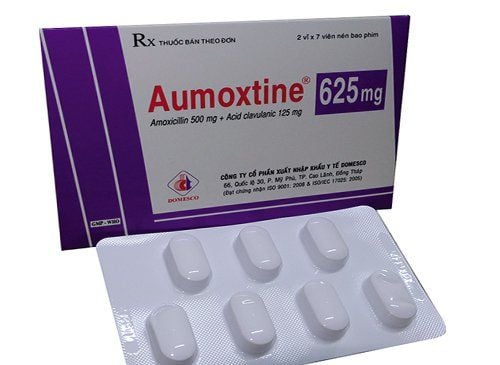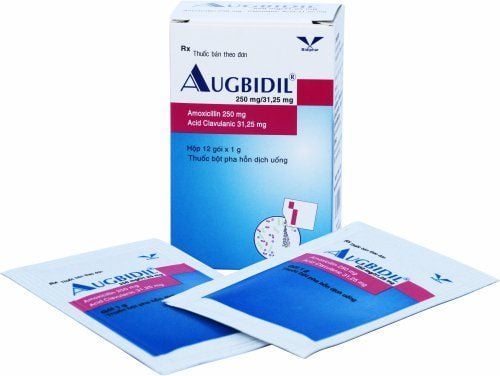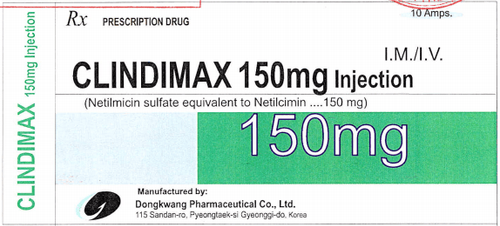This is an automatically translated article.
Cefoperazone 1g is a 3rd generation cephalosporin antibiotic. The drug is prepared in the form of a sterile powder for injection, used to treat many different bacterial infections.
1. Uses of the drug Cefoperazone 1g
Cefoperazone has an antibacterial effect through inhibition of bacterial cell wall synthesis. The spectrum of action of Cefoperazone is quite broad, including: Gram-positive aerobic bacteria, gram-negative aerobic bacteria, anaerobic bacteria, other pathogenic bacteria,... Indications for use of Cefoperazone 1g:Sensitive infections, especially Pseudomonas spp; Severe infections caused by susceptible gram-positive and gram-negative bacteria and other organisms already resistant to beta-lactam antibiotics; Infections such as: Infections of the biliary tract, upper and lower respiratory tract, pelvic inflammatory and obstetric and gynecological infections, skin and soft tissue, bone and joint, kidney and urinary tract infections, gonorrhea, sepsis, peritonitis peritoneum and intra-abdominal infections,...; Alternative to certain broad-spectrum penicillins with or without aminoglycosides for the treatment of Pseudomonas infections in penicillin-sensitive individuals. If Cefoperazone is used to treat Pseudomonas infections, it should be combined with an aminoglycoside. On the other hand, Cefoperazone 1g is not prescribed for people with a history of allergy to Cefoperazone and cephalosporin antibiotics.
2. How to use and dose of Cefoperazone 1g
2.1. Administration: Use as sodium salt, deep intramuscular injection or intravenous infusion intermittently (15-30 minutes) or continuously. Doses are expressed as the corresponding Cefoperazone (every 1.03 g Cefoperazone sodium is equivalent to 1 g Cefoperazone). Although Cefoperazone has been administered by slow intravenous injection over 3 to 5 minutes, rapid intravenous administration is not recommended.
2.2. Dosage Adults: Mild and moderate infections use 1-2g dose, every 12 hours. For severe infections, up to 12g/24 hours can be used, divided into 2-4 doses. There are cases of immunocompromised patients receiving doses up to 16g/day by continuous infusion. Cefoperazone therapy for group A beta-hemolytic Streptococcus infections should be continued for at least 10 days to prevent glomerulonephritis or acute rheumatic fever. For patients on hemodialysis, a dose adjustment of Cefoperazone may be necessary after hemodialysis (because Cefoperazone is partially eliminated during hemodialysis); Children: Intravenous injection for children with a dose of 25-100mg/kg, every 12 hours; infants with a dose of 50mg/kg, every 12 hours; Children with a dose of 25-50mg/kg, every 6-12 hours/time. The maximum dose is 400mg/kg/day, not to exceed 6g/day. Due to the toxic nature of benzyl alcohol to neonates, it is not recommended to administer intramuscularly to neonates with the drug mixed with a solution containing benzyl alcohol (bacteriostatic agent); Patients with renal impairment: Cefoperazone can be used at the usual dose without dose adjustment because the drug is eliminated via the biliary tract. If there are signs of drug accumulation, the dose should be reduced accordingly' Patients with liver disease or biliary obstruction: Do not take more than 4g/24 hours. Or the dose for people with liver and kidney failure is 1-2g/24 hours. If higher doses are used, plasma concentrations of cefoperazone should be monitored. 2.3. Overdose Symptoms of drug overdose include increased neuromuscular excitability, convulsions (especially in patients with renal failure). In case of drug overdose, it is necessary to protect the patient's airway, support ventilation and give fluids. If the patient has a seizure, stop using the drug, anticonvulsant therapy can be used if clinically indicated. Hemodialysis can also help remove drugs from the blood. In addition, supportive or symptomatic treatment can be given.
3. Side effects of the drug Cefoperazone
Some side effects patients may encounter when using Cefoperazone 1g include:
Common: Diarrhea, maculopapular skin rash, positive Coombs test, transient eosinophilia; Uncommon: Fever, hemolytic anemia, reversible neutropenia, thrombocytopenia, urticaria, skin pruritus, phlebitis at the site of infusion, transient pain at the site of intramuscular injection; Rare: Convulsions (with high doses and impaired renal function), restlessness, headache, nausea, vomiting, pseudomembranous colitis, hypoprothrombinemia, erythema multiforme, cholestatic jaundice, increased mild ALT, AST and alkaline phosphatase, Stevens-Johnson syndrome, interstitial nephritis, nephrotoxicity with transient elevation of blood urea/creatinine, arthralgia, candidiasis, serum sickness,... When experiencing side effects of the drug Cefoperazone, patients should notify their doctor for early support and timely intervention.
4. Be careful when using Cefoperazone 1g
Some notes for patients to remember when using Cefoperazone 1g:
There have been hypersensitivity cross-reactions (including anaphylaxis) among patients who are allergic to beta-lactam antibiotics, so Cefoperazone should be used. cautiously. Patients should be monitored for signs and symptoms of anaphylaxis during the initial administration of the drug, and emergency measures should be prepared if the patient is previously allergic to penicillin. However, with Cefoperazone, the rate of cross-sensitivity reactions to penicillin was lower; Long-term use of Cefoperazone may result in the growth of non-susceptible strains of bacteria. If superinfection occurs, the patient needs to stop using the drug; Caution should be exercised when prescribing broad-spectrum antibiotics to patients with gastrointestinal disease (especially colitis); Monitor prothrombin time in individuals at risk of hypoprothrombinemia and administer vitamin K if necessary. Prothrombin levels should be monitored in patients with malabsorption or receiving parenteral nutrition, adding vitamin K if necessary; Cefoperazone should be used with caution in pregnant women and nursing mothers, only when absolutely necessary (as prescribed by a doctor).
5. Drug interactions Cefoperazone 1g
Some drug interactions of Cefoperazone 1g include:
Using Cefoperazone with aminoglycosides may increase the risk of nephrotoxicity; The antibacterial activity of Cefoperazone and aminoglycosides in vitro may be synergistic against several gram-negative bacteria, including P. aeruginosa and Serratia marcescens; Concomitant use of Cefoperazone with heparin and warfarin may increase the hypoprothrombinemic effect of Cefoperazone, increasing the risk of bleeding; When using Cefoperazone concurrently with hepatotoxic drugs, it is necessary to monitor liver function; Cefoperazone may decrease the effectiveness of typhoid vaccine; Cefoperazone may cause false positive results in urine glucose tests; If you drink alcohol during treatment and within 72 hours after using Cefoperazone, you may experience symptoms such as sweating, skin flushing, headache, nausea, vomiting, tachycardia, etc. .; There is an incompatibility between Cefoperazone and aminoglycosides, so it is necessary to use each drug separately, not in combination. When using Cefoperazone 1g, patients should inform their doctor about their medical history and any medications they are taking. If there are any unusual symptoms, the patient should immediately notify the doctor to receive appropriate advice.
Please dial HOTLINE for more information or register for an appointment HERE. Download MyVinmec app to make appointments faster and to manage your bookings easily.













